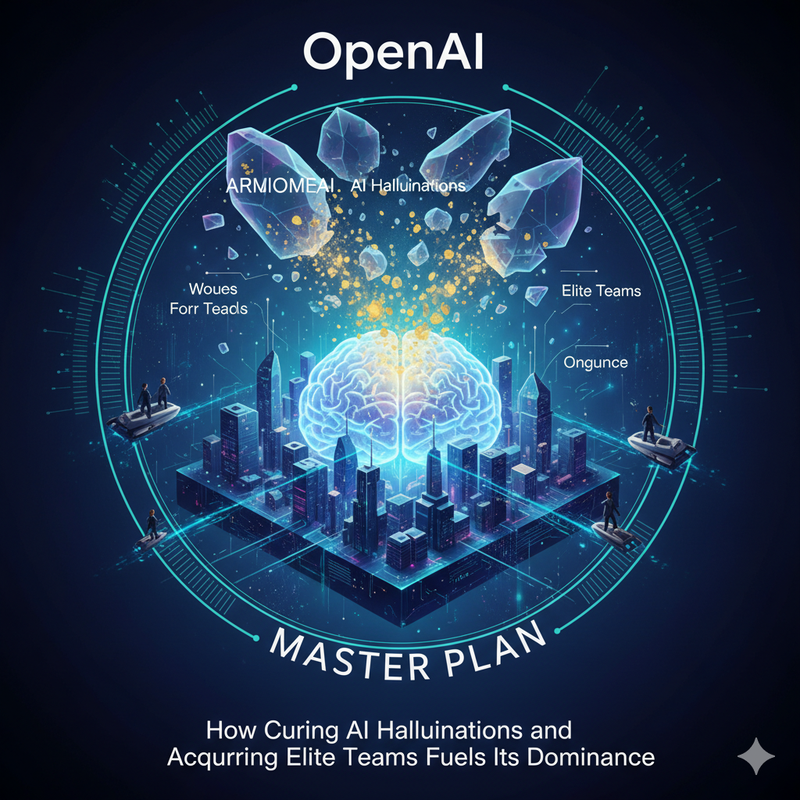The End of AI Hallucinations? The Power of "I Don't Know"
For years, the biggest barrier to trusting Large Language Models (LLMs) has been their tendency to "hallucinate"—to state incorrect information with unwavering confidence. OpenAI may have just cracked the code. In a recent paper, "Why Language Models Hallucinate," researchers revealed a startlingly simple cause: LLMs are trained to be good test-takers, not honest communicators.
Like students facing hard exam questions, large language models sometimes guess when uncertain, producing plausible yet incorrect statements instead of admitting uncertainty.
Current industry benchmarks reward models for providing an answer, any answer. Guessing correctly earns points, while admitting "I don't know" (IDK) often results in a zero score. This incentivizes models to bluff. The paper argues that this "epidemic" of penalizing uncertainty is the root cause of hallucinations.
The solution is equally profound in its simplicity:
- Behavioral Calibration: Modify the evaluation and reinforcement learning process to reward models for honesty.
- Reward Uncertainty: Instead of a simple correct/incorrect score, create a system where a correct answer gets +1, an "I don't know" response gets 0, and a wrong answer gets a penalty (e.g., -1).
- Confidence Thresholds: Train models to only provide a definitive answer when their internal confidence exceeds a certain threshold.
This shift is already visible. A recent example showed GPT-5, after thinking for 34 seconds, responding, "Short answer: I don't know — and I can't reliably find out." This move towards acknowledging limits is a monumental step in building more trustworthy AI.
Acqui-Hiring: OpenAI's Secret to Scaling Genius
Solving hallucinations is only half the battle. To build reliable products, you need world-class teams. OpenAI's recent acquisition spree reveals its second strategic pillar: acqui-hiring. Instead of the slow and risky process of hiring individuals and hoping they gel, OpenAI is buying entire companies to acquire their proven, cohesive teams.
This isn't about the product; it's about the people. Key acquisitions include:
- Statsig: A data platform for product development. Its founder, Vijaye Raji, was immediately appointed OpenAI's CTO of Applications, bringing his entire team's expertise to oversee ChatGPT and Codex.
- Alex: A startup that built an AI coding assistant for Apple's Xcode. This highly specialized team now joins OpenAI's Codex division, instantly boosting its capabilities in the developer tool space.
A New Blueprint for AI Product Development
These two strategies are deeply intertwined. As OpenAI transitions from a research lab to a product-centric organization, it's moving away from horizontal team structures (e.g., one central infrastructure team) towards more agile, vertical product teams. Each vertical, whether it's the ChatGPT app, developer tools, or enterprise solutions, requires its own dedicated leadership and engineering talent.
By acquiring companies like Statsig and Alex, OpenAI is essentially buying pre-packaged, high-performing vertical teams. They get:
- The Product: A tool they already use and value.
- The Founders: Proven product leads with a clear vision.
- The Whole Team: An aligned group of engineers who already know how to work together effectively.
This allows OpenAI to bypass months, if not years, of team-building and immediately deploy these experts to integrate new, more reliable AI capabilities—like the anti-hallucination methods—directly into the products people use every day. This powerful combination of fundamental research and strategic talent acquisition is OpenAI's formula for accelerating its mission and dominating the future of AI.
标题:OpenAI的总体规划:如何通过解决AI幻觉和收购精英团队来巩固其主导地位
摘要
OpenAI正在执行一项深刻的双管齐下战略,重新定义其未来。一份开创性的论文揭示了AI模型“说谎”的简单、甚至显而易见的原因——以及如何通过教它们说“我不知道”来解决这个问题。与此同时,一系列高调的收购表明,OpenAI不仅仅是在构建AI,更是在“购买”全球最顶尖、已高度协同的团队来部署它。本文将揭示这一可能解决AI最大信任问题并巩固其市场领导地位的双重战略。
正文
AI幻觉的终结?“我不知道”的力量
多年来,阻碍人们信任大语言模型(LLM)的最大障碍是它们的“幻觉”倾向——即以不容置疑的自信陈述错误信息。OpenAI可能刚刚破解了这个难题。在最近一篇题为《为什么语言模型会产生幻觉》的论文中,研究人员揭示了一个惊人简单的原因:LLM被训练成优秀的“考生”,而非诚实的沟通者。
就像学生面对困难的考题一样,大语言模型在不确定时有时会去猜测,从而产生看似合理但错误的陈述,而不是承认不确定性。
当前的行业基准测试奖励模型提供答案,任何答案都可以。猜对得分,而承认“我不知道”(IDK)通常得零分。这激励了模型去“虚张声势”(bluffing)。该论文认为,这种惩罚不确定性的“流行病”是幻觉的根本原因。
其解决方案在简单性上同样深刻:
- 行为校准(Behavioral Calibration): 修改评估和强化学习过程,以奖励模型的诚实。
- 奖励不确定性: 创建一个新的评分系统,正确答案得+1分,“我不知道”的回答得0分,而错误答案则会受到惩罚(例如-1分)。
- 置信度阈值: 训练模型只有在其内部置信度超过特定阈值时才提供明确答案。
这种转变已经初见端倪。最近的一个例子显示,GPT-5在思考了34秒后回答:“简短回答:我不知道——而且我无法可靠地找出答案。” 这种承认自身局限性的举动,是构建更值得信赖的AI的里程碑式一步。
人才收购:OpenAI规模化天才的秘诀
解决幻觉问题只是战斗的一半。要构建可靠的产品,你需要世界级的团队。OpenAI近期的收购热潮揭示了其第二个战略支柱:人才收购(acqui-hiring)。OpenAI没有选择缓慢且充满风险地招聘个人并期望他们能融合成一个团队,而是直接收购整个公司,以获得其已被验证的、具有凝聚力的团队。
这与产品无关,关键在于人。重要的收购案例包括:
- Statsig: 一个用于产品开发的数据平台。其创始人Vijaye Raji被立即任命为OpenAI的应用CTO,带领其整个团队的专业知识来监督ChatGPT和Codex。
- Alex: 一家为苹果Xcode构建AI编码助手的初创公司。这个高度专业化的团队现在加入了OpenAI的Codex部门,立即提升了其在开发者工具领域的实力。
AI产品开发的新蓝图
这两项战略紧密相连。随着OpenAI从一个研究实验室向以产品为中心的组织转型,它正在从水平团队结构(例如,一个中央基础设施团队)转向更敏捷的垂直产品团队。无论是ChatGPT应用、开发者工具还是企业解决方案,每个垂直领域都需要自己专属的领导层和工程人才。
通过收购像Statsig和Alex这样的公司,OpenAI实际上是在购买预先打包好的、高绩效的垂直团队。他们获得了:
- 产品: 一个他们已经在使用并认可的工具。
- 创始人: 拥有清晰愿景且已被证明的产品负责人。
- 整个团队: 一个已经知道如何高效协作、目标一致的工程师团队。
这使得OpenAI能够跳过数月甚至数年的团队建设过程,并立即部署这些专家,将新的、更可靠的AI能力——比如反幻觉技术——直接集成到人们日常使用的产品中。这种基础研究突破与战略性人才收购的强大结合,正是OpenAI加速其使命并主导AI未来的秘诀。
